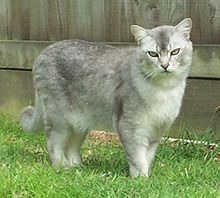Burmilla
| Burmilla | |
|---|---|

A "blue" male Burmilla
|
|
| Other names | none |
| Origin | United Kingdom |
| Breed standards | |
| FIFe | standard |
| ACF | standard |
| CCA-AFC | standard |
| Domestic cat (Felis catus) | |
The Burmilla is a breed of domestic cat which originated in the United Kingdom in 1981. It is a cross between the Chinchilla Persian and Burmese breeds. Standards were produced in 1984, and the breed gained championship status in the United Kingdom in the 1990s.
The Burmilla was originally created accidentally in the United Kingdom. Two cats, a Chinchilla Persian named Sanquist, and Fabergé which was a Brown tortie burmese were both awaiting a partner of their own breed in different rooms. One night the cleaner left the door open. The two cats bred, producing four kittens born in 1981 that were so adorable that a new breed was born.
In GCCF (Governing Council of the Cat Fancy), the Burmilla is considered part of the Asian cat breed. It is accepted in FIFe as the Burmilla. Only the Shaded and Tipped Silver varieties have been recognised in FIFe, CCCA, ACF and CFA as the Burmilla. As of late 2011 the Golden Shaded and Tipped Burmilla is also recognised within FIFe. One governing body in Australia has used the name Australian Tiffanie, however, there is not international acceptance and standardisation for this breed - Tiffany has been used to describe many different breeds having the appearance from Ragdoll to Birman and may contain any of these breeds and more. Many Australian Tiffanies in Australia contain more than three-quarters Persian Chinchilla and retain the appearance and temperament of the Old Fashioned Chinchilla. The name's use is declining in favour due to the lax standards for the breed name, the lack of unique identity and varied genetic makeup.
Burmillas are medium-sized with muscular yet elegant bodies, tending to weigh between 3–6 kg. Their distinguishing feature is their sparkling silver coat, and distinctive “make up” lining the nose, lips and eyes.
Gently rounded top of head; medium width between ears; wide at eyebrow level and jaw hinge, tapering to a short, blunt wedge. The profile shows a gentle nose break. Tip of nose and chin should be in line. Chin is firm, with good depth.
Medium to large, broad at base with slightly rounded tips. Ear set with slight forward tilt in profile. Eye shape is large; placed well apart at slight oblique setting; slightly curved upper; line angeled toward the nose, with a fuller curved lower line. Eye color luminous, any shade of green. Some allowance can be made for a gold or yellow tinge in kittens and young adults.
The Burmilla comes in two coat lengths, semi long hair and shorthair. Semi long hair Burmilla are known as Tiffanie in GCCF. The most common (standard) coat is the short-hair. This is a short, close-lying coat similar in appearance to the Burmese but with slightly padded feel due to the undercoat, it has a very soft, silky feel. The recessive longhair gene inherited from the Chinchilla can produce Longhair Burmilla. These cats have a semi-longhair coat following the lines of the body, with a soft, silky feel and a large plumed tail. The Shorthair gene is dominant, and where a cat receives one of each, the appearance will be Shorthair. Two Longhair Burmillas mated together will always produce Longhair kittens, while Shorthair matings depend on whether the Longhair genes are carried by the Shorthair parents.
...
Wikipedia
